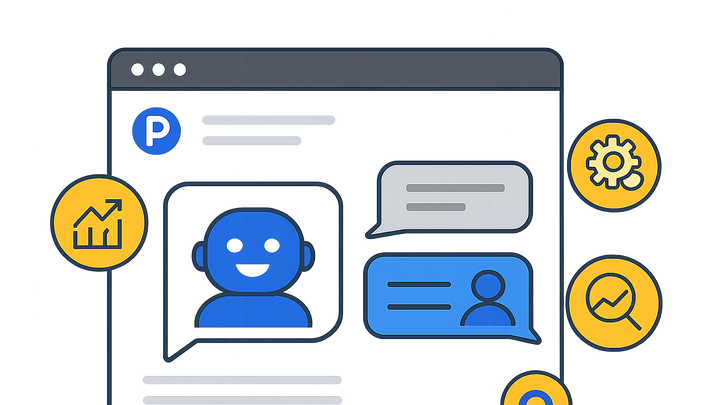Published on 2025-06-29T21:11:17Z
What is a Chatbot? Significance and Examples for CRO, UX & SEO
A chatbot is a software application that simulates human conversation, typically using artificial intelligence and pre-defined rules to interact with website visitors. In the context of conversion rate optimization (CRO), user experience (UX), and search engine optimization (SEO), chatbots serve as proactive engagement tools that guide users, capture leads, and collect behavioral insights. They can reduce friction in the user journey by providing instant answers, personalized recommendations, and seamless navigation support. Chatbots also contribute to SEO by improving engagement signals such as dwell time and page views, which search engines may reward with higher rankings. Integrating chatbots effectively requires careful design, placement, and ongoing performance measurement to align with business goals and accessibility standards.
Chatbot
An AI-driven chat interface on websites that engages visitors, drives conversions, enhances UX, and improves SEO signals.
Definition and Role of Chatbots in CRO, UX, and SEO
Chatbots are AI-powered tools embedded on websites to interact with visitors via text or voice. They automate common queries, guide navigation, and collect data to improve conversion rates, user satisfaction, and search visibility.
-
Automated visitor engagement
Chatbots proactively greet users, answer common questions, and guide visitors through the site, reducing friction and improving user satisfaction.
- Proactive triggers:
Chatbots can initiate conversations based on user behavior, such as time on page or exit intent.
- 24/7 availability:
They provide instant assistance at any time, addressing user queries outside business hours.
- Proactive triggers:
-
Lead generation and qualification
Chatbots capture user information, qualify leads through tailored conversational flows, and route high-intent leads to sales teams.
- Form replacement:
Conversational forms can increase completion rates by breaking information requests into single questions.
- Intent scoring:
Chatbots can assign scores based on responses to prioritize follow-up.
- Form replacement:
-
Enhanced user experience
By delivering immediate, context-aware responses, chatbots reduce bounce rates and facilitate smoother navigation.
- Guided navigation:
They can direct users to relevant pages or resources based on their queries.
- Personalization:
Chatbots leverage user data to tailor interactions, improving engagement.
- Guided navigation:
Benefits of Chatbots for CRO, UX, and SEO
Integrating chatbots into websites can deliver measurable improvements in conversion rates, user satisfaction, and search visibility.
-
Boosted conversion rates
Targeted chat messages at critical points can recover abandoning visitors and drive conversions.
- Exit-intent offers:
Deploy special promotions when users show exit intent.
- Up-selling and cross-selling:
Recommend related products during conversations to increase order value.
- Exit-intent offers:
-
Improved engagement metrics
Chat interactions increase session duration and page views, sending positive signals to search engines.
- Reduced bounce rate:
Interactive chat keeps users on the site longer.
- Increased dwell time:
Engaging dialogues encourage deeper exploration of content.
- Reduced bounce rate:
-
Valuable user insights
Chats collect qualitative data on user pain points, informing UX improvements and content strategies.
- Common queries analysis:
Identify frequent questions to optimize FAQs and content.
- Sentiment tracking:
Gauge user satisfaction through conversational sentiment analysis.
- Common queries analysis:
Implementing Chatbots with Prevue.me
prevue.me offers actionable CRO, SEO, UX, and accessibility critiques to optimize chatbot deployment and performance.
-
Audit chatbot placement
Use prevue.me to evaluate the visibility and timing of chatbot triggers across your site.
- Visibility check:
Ensure chat widgets are easily discoverable without obstructing content.
- Example embed code:
<div id="chatbot-widget"></div> <script src="https://cdn.prevue.me/chatbot.js"></script>
- Visibility check:
-
Optimize conversation flow
Leverage prevue.me’s critiques to refine prompts, reduce friction, and align chat flows with user intent.
- Prompt clarity:
Ensure each question is concise and contextually relevant to user needs.
- Segmentation rules:
Use branching logic to customize paths for different user segments.
- Prompt clarity:
-
Accessibility and ux compliance
prevue.me checks chatbot interfaces for WCAG compliance and overall user experience issues.
- Keyboard navigation:
Verify that all chat controls are accessible via keyboard without dead-ends.
- Aria labels:
Ensure interactive elements have descriptive ARIA attributes for screen readers.
- Keyboard navigation:
Best Practices and Common Pitfalls
Follow these guidelines to maximize chatbot effectiveness and avoid common implementation mistakes.
-
Maintain conversational tone
Use natural language and clear responses to build trust and engagement.
- Regular updates:
Continuously improve chatbot scripts based on user feedback and analytics.
- Avoid jargon:
Write in plain language to cater to a broad audience.
- Regular updates:
-
Balance automation with human support
Provide seamless transitions to human agents for complex issues beyond the chatbot’s scope.
- Fallback messages:
Offer clear guidance when the chatbot cannot handle a request.
- Live agent handoff:
Ensure smooth transfer controls and notifications for users and agents.
- Fallback messages:
-
Respect user boundaries
Trigger chats respectfully to avoid disrupting the user experience.
- Frequency limits:
Control how often chat prompts appear during sessions.
- User control:
Allow users to minimize or dismiss the chat interface easily.
- Frequency limits:
Measuring Success
Key metrics to track chatbot performance and impact on CRO, UX, and SEO.
-
Interaction rate
Percentage of visitors who engage with the chatbot out of total site visits.
- Sessions with chat:
Count of sessions where the chatbot was activated.
- Clicks on chat invites:
Rate of users clicking on initial chat prompts.
- Sessions with chat:
-
Lead conversion rate
Ratio of qualified leads captured by the chatbot to total chat interactions.
- Form completion rate:
Percentage of users completing chat-based forms.
- Revenue attribution:
Assign conversion value to chatbot-generated leads.
- Form completion rate:
-
User satisfaction and retention
Measure user satisfaction through post-chat surveys and retention metrics.
- Csat score:
Average satisfaction rating from user surveys.
- Repeat visits:
Track if chatbot users return for further interactions.
- Csat score:
